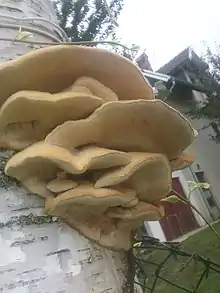Sarcodontia crocea
Sarcodontia crocea is a species of toothed crust fungus in the family Meruliaceae. The species was first described scientifically in 1822 by Lewis David de Schweinitz, who called it Sistotrema croceum.[2] It was transferred to the genus Sarcodontia by Czech mycologist František Kotlaba in 1953.[3] S. crocea usually occurs on old fruit trees, in which it causes a white rot. It is found in Europe, Asia, and North America. It is red-listed in several European countries.[4]
| Sarcodontia crocea | |
|---|---|
 | |
| ' | |
| Scientific classification | |
| Kingdom: | |
| Division: | |
| Class: | |
| Order: | |
| Family: | |
| Genus: | |
| Species: | S. crocea |
| Binomial name | |
| Sarcodontia crocea | |
| Synonyms[1] | |
| |
Fresh fruit bodies of S. crocea have an intense, fruity odour resembling pineapple or grated apples. The furan-derived compounds 4-(furan-3-yl)benzaldehyde and 4-(5-oxotetrahydrofuran-3-yl)benzaldehyde have been identified as contributing to this odour.[5]
References
- "GSD Species Synonymy: Sarcodontia crocea (Schwein.) Kotl". Species Fungorum. Kew Mycology. Retrieved 2017-09-14.
- Schweinitz, L.D. (1822). "Synopsis fungorum Carolinae superioris secundum observationes". Schriften der Naturforschenden Gesellschaft zu Leipzig (in Latin). 1: 20–131.
- Kotlaba, F. (1953). "Nebezpecný parasit jabloní — Sarcodontia crocea (Schweinitz) c. n.". Ceská Mykologie. 7 (3): 117–123.
- Szczepkowski, Andrzej (2010). "Sarcodontia crocea (Polyporales, Basidiomycota) in Poland – distribution and decay ability in laboratory conditions". Polish Botanical Journal. 55 (2): 489–498.
- Kokubun, Tetsuo; Rozwadowski, Zbigniew; Duddeck, Helmut (2007). "Benzaldehyde derivatives from Sarcodontia crocea". Journal of Natural Products. 70 (9): 1539–1541. doi:10.1021/np070305s. PMID 17822300.
This article is issued from Wikipedia. The text is licensed under Creative Commons - Attribution - Sharealike. Additional terms may apply for the media files.